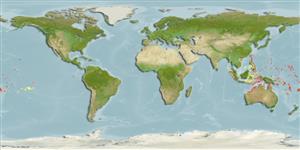>
Blenniiformes (Blennies) >
Blenniidae (Combtooth blennies) > Salariinae
Etymology: Rhabdoblennius: Greek, rhabdos = stick + Greek, blennios = mucus (Ref. 45335).
More on author: Fowler.
Environment: milieu / climate zone / depth range / distribution range
Ökologie
seewasser riff-verbunden; tiefenbereich 0 - 3 m (Ref. 90102). Tropical
Pacific Ocean: the Solomons to American Samoa.
Size / Gewicht / Alter
Maturity: Lm ? range ? - ? cm
Max length : 7.0 cm TL Männchen/unbestimmt; (Ref. 30874)
Rückenflossenstacheln (insgesamt): 12; Rückenflossenweichstrahlen (insgesamt): 18-19; Afterflossenstacheln 2; Afterflossenweichstrahlen: 19 - 21
Facultative air-breathing (Ref. 126274); Adults inhabit reef flats, benches, and rocky shorelines exposed to strong wave action (Ref. 37816). They occur solitary or in groups (Ref. 90102). Oviparous. Eggs are demersal and adhesive (Ref. 205), and are attached to the substrate via a filamentous, adhesive pad or pedestal (Ref. 94114). Larvae are planktonic, often found in shallow, coastal waters (Ref. 94114).
Life cycle and mating behavior
Geschlechtsreife | Fortpflanzung | Ablaichen | Eier | Fecundity | Larven
Oviparous, distinct pairing (Ref. 205).
Bath, H., 2004. Revision of the genus Rhabdoblennius Whitley (Pisces: Blenniidae: Salariinae), with descriptions of two new species. Stuttg. Beitr. Naturkd. (A Biol.) 669:1-28. (Ref. 76835)
IUCN Rote Liste Status (Ref. 130435)
Bedrohung für Menschen
Harmless
Nutzung durch Menschen
Mehr Information
ReferenzenAquakulturAquakultur ProfilZuchtlinienGenetikElectrophoresesVererbbarkeitKrankheitenVerarbeitungNutrientsMass conversion
Tools
Zusatzinformationen
Download XML
Internet Quellen
Estimates based on models
Preferred temperature (Ref.
123201): 26.6 - 29.4, mean 28.6 °C (based on 949 cells).
Phylogenetic diversity index (Ref.
82804): PD
50 = 0.5312 [Uniqueness, from 0.5 = low to 2.0 = high].
Bayesian length-weight: a=0.01072 (0.00480 - 0.02393), b=3.01 (2.82 - 3.20), in cm total length, based on LWR estimates for this (Sub)family-body shape (Ref.
93245).
Trophic level (Ref.
69278): 2.0 ±0.00 se; based on food items.
Widerstandsfähigkeit (Ref.
120179): hoch, Verdopplung der Population dauert weniger als 15 Monate. (Preliminary K or Fecundity.).
Fishing Vulnerability (Ref.
59153): Low vulnerability (10 of 100).
Nutrients (Ref.
124155): Calcium = 198 [101, 389] mg/100g; Iron = 1.09 [0.61, 1.90] mg/100g; Protein = 18.4 [17.2, 19.6] %; Omega3 = 0.117 [0.062, 0.217] g/100g; Selenium = 15.7 [7.9, 33.3] μg/100g; VitaminA = 124 [34, 478] μg/100g; Zinc = 3.12 [1.98, 4.63] mg/100g (wet weight);
